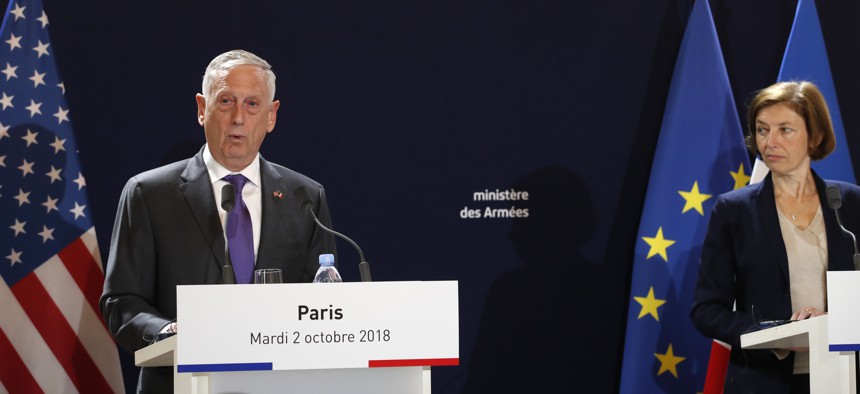
U.S Defense Secretary Jim Mattis, left, and French counterpart Florence Parly attend a joint press conference in Paris, Turesday, Oct.2, 2018. AP Photo/Christophe Ena
Trump Officials Target Iran, Raising Question of US Military’s Role in Mideast
Some fear the strategy opens the door to strikes on Iranian forces inside Syria — and direct armed conflict with Tehran.
Trump administration officials escalated their campaign to counter Iran in a slate of diplomatic announcements on Wednesday, punctuating a week of warnings that have ratcheted up bilateral tension and further fueled speculation that the United States is inching closer to an armed conflict with Tehran or its proxies' fighters in the Middle East.
The imbroglio began a week ago on the sidelines of the United Nations General Assembly’s annual opening session in New York.
For years, the Pentagon has claimed that U.S. troops are in Syria for one purpose: to fight the Islamic State. Officials insist that American forces are not there to fight in the ongoing civil war in that country, which for eight years has been fought by a tangled web of foreign alliances that includes thousands of Iranian and Russian fighters backing President Bashar al-Assad’s regime.
But a series of tough-on-Iran remarks from National Security Advisor John Bolton raised questions about whether the military’s mission in Syria and beyond is expanding to include countering Tehran.
Related: US Official: We May Cut Support for Iraq If New Government Seats Pro-Iran Politicians
Related: Trump’s Latest Warning to Iran Didn’t Come out of Nowhere
Related: US Enters Its Next Phase in Its Strategy to Pressure Iran
Bolton told reporters that the U.S. would not be leaving Syria “as long as Iranian troops are outside Iranian borders.” In separate prepared remarks, he vowed that the U.S. “will come after you” if Tehran continues to “cross” the U.S.
“The murderous regime and its supporters will face significant consequences if they do not change their behavior,” said Bolton. “Let my message today be clear: We are watching, and we will come after you.”
On Wednesday, Secretary of State Mike Pompeo blamed Iran for threats on American personnel in Iraq and withdrew from an Eisenhower-era “treaty of amity” with Tehran that has been used by both countries as the basis for resolving claims in the International Court of Justice.
“Iran is the origin of the current threat to Americans in Iraq,” Pompeo told reporters, days after he announced the closure of the U.S. mission in Basra following a rocket attack on the facility. “Our intelligence in this regard is solid. We can see the hand of the ayatollah and his henchmen supporting these attacks on the United States.”
The Trump administration has made constraining Iranian influence in the Middle East a core pillar of its foreign policy in the region. In a dramatic press conference a few weeks into his presidency, then-national security advisor Michael Flynn announced that the administration was “officially putting Iran on notice”—with little explanation of the practical impact of that announcement. In May, President Donald Trump withdrew from the so-called Iran nuclear deal, which traded sanctions relief for curbs on Iran’s nuclear weapons development program; the full weight of the re-imposed sanctions will flip on in November.
The U.S. is involved in several conflicts beyond Syria where Iran-aligned forces also are active.
In the ongoing civil war in Yemen, the Pentagon is providing intelligence and targeting support to the Saudi-UAE coalition battling the Iranian-backed Houthi rebels. U.S. officials insist Iran has smuggled to the Houthis ballistic missiles and IED drone planes and boats used against American, Saudi, and Emirati military and civilian targets, including commercial ships of Yemen’s coast. In Iraq, the State Department is working to exclude Iran-aligned politicians from the as-yet unformed government while the military continues to provide training and other assistance to Iraqi security forces. There, the situation is particularly complicated: an Iran-aligned group placed second in national parliamentary elections in May.
Currently, Congress has passed no legal authorization for U.S. military forces to directly engage with Iranian or Iranian-backed groups, raising questions from lawmakers about the administration’s intent. Defense Department officials have struggled to explain Bolton’s remarks and the of how the Trump administration intends to constrain Iran across the Middle East—and what role the military will play in that effort—remains unclear.
So far, U.S. military personnel operating in the region have received no new guidance from Washington. Officials from Defense Secretary James Mattis down to U.S. Central Command, or CENTCOM—the operational component of the military responsible for American troops in the Middle East—still say that the military is solely tasked with countering ISIS.
“Militarily in Syria, we remain focused on defeating the remnants of ISIS and stabilizing liberated territory to prevent the group's resurgence,” CENTCOM spokesman Maj. Josh T. Jacques said in an email.
Col. Sean Ryan, spokesman for U.S.-led forces in Baghdad, this week also said he had received no change in guidance to support a new agenda on Iran.
U.S. officials long have said that the U.S. military presence in Syria plays a role in the administration’s Iran strategy. Boots on the ground there “can constrain Iran’s freedom of maneuver” and “empower our diplomats to put more pressure on Iran,” Assistant Secretary of Defense for International Security Affairs Robert Karem told a House Armed Services subcommittee last week.
He argued that these are only incidental benefits, not the operational purpose of the troop presence.
The escalation in rhetoric and the growing fears of military engagement come at a paradoxical moment. The U.S. is also drawing down some of its defensive capabilities in the region, removing a handful of Patriot missile batteries from Gulf allies.
Pentagon officials have tried to give a more nuanced explanation of Bolton’s comments, describing the removal of Iranian influence from Syria as a necessary byproduct of a political settlement to the war that will prevent the re-emergence of ISIS.
Karem told lawmakers that lawmakers should “disaggregate… our overall U.S. policy objectives from our military activities.”
“I think what the national security adviser and others recognize is that as long as Iran continues to pose a threat, as long as Iran continues to engage in destabilizing activities, as long as it continues to foment sectarianism in Syria, it's going to be very difficult to end this war,” Karem said. “And until that happens, it's going to be very difficult for us to secure the conditions to allow for the enduring defeat of ISIS.”
In other words, officials suggest, the departure of Iranian military groups from the country is part of a whole-of-government strategy for creating an ISIS-free Syria—and not a new military mission. Mattis and others have emphasized the role of the U.S. diplomatic corps in Syria while denying a broadening role for the military. On Tuesday, the secretary announced in Paris that the U.S. has doubled its diplomatic presence in Syria—a somewhat unusual announcement coming from a defense secretary, rather than a State Department official.
“Our diplomats there on the ground have been doubled in number,” Mattis told reporters during a press conference in Paris with his French counterpart. “As we see the military operations becoming less, we will see the diplomatic effort now able to take [root].”
He did not give specific numbers. The U.S. does not provide consular services in Syria.
Lawmakers and some former officials are suspicious of Pentagon denials of “mission creep.”
Robert Ford, former U.S. ambassador to Syria from 2010 to 2014, said the fight against ISIS has “metamorphosed” into “putting pressure somehow, in some undescribed, not-detailed manner” on Iran.
“It’s a mission that’s expanding, but they don’t explain how they’re going to achieve the mission—it’s all very nebulous,” he said. “How are you going to get the Iranians out of Syria by leaving 2,200 troops there?”
In Iraq, one former U.S. official with deep experience in the Middle East raised concerns that the administration’s public posturing towards Iran might make the security situation there worse and put Western civilians in Iraq at risk for targeting.
"What I’m most concerned about is if the Americans say we're going to push back on Iran in Iraq, they're going to fight asymmetrically,” the former official said.
“That’s exactly what’s going to start happening if America starts announcing that we’re going to push back on Iran in Iraq. They’re going to plink a couple of journalists. They’re going to plink a couple of businessmen running around. Stupid and foolish."
Lawmakers, meanwhile, have zeroed in on Trump’s legal authority to strike Iranian forces. Karem confirmed that the administration does not interpret the 2001 Authorization for Use of Military Force, or AUMF, to cover engagement with Iran, and insisted that the U.S. military force is focused on fighting ISIS.
But those arguments did not soothe concerns from Democrats.
“That's not what the national security adviser said,” said Rep. Seth Moulton, a Democrat from Massachusetts who served four tours in Iraq with the Marine Corps. “He said that the military presence will last in Syria until Iran withdraws its forces.”
“That to me sounds like an operation against Iran, which you've just stated is not allowed under the Authorization for Use of Military Force.”
A group of Senate Democrats has introduced legislation that would prohibit the use of funds “for kinetic military operations in or against Iran except pursuant to an Act or joint resolution of Congress specifically authorizing such use.”
In what could later prove to be the most important development of the day, the Pentagon’s internal interpretation of its legal authority to carry out tactical strikes in the context of “collective self defense” was made public. According to an excerpt of a letter from Mattis sent to Sen. Tim Kaine, D-Va., the Defense Department believes that collective self defense—a legal principle that lets nations use military force to defend allies—gives it the authority to carry out strikes in defense of partner forces even if the target of those strikes is not covered by a congressional AUMF.
Kaine has raised questions about the process by which the Defense Department determines who is a “partner force,” suggesting that the Pentagon could simply slap the designation on any group it wished in order to carry out airstrikes on a desired target in the name of collective self defense.
Steve Vladeck, a national security professor at the University of Texas Law School, called it “a subtle but important expansion in the claimed power to use military force that the Trump administration is advancing.”
It’s also an expansion that could theoretically be used to justify a strike on Iran or Iran-backed forces.
Gen. Joseph Votel, the head of CENTCOM, denied that possibility on Thursday.
“I don’t think we’re seeking to go to war with Iran,” he told reporters.




